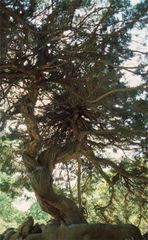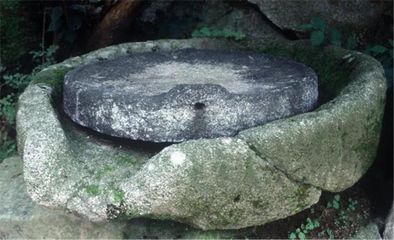보문사
| 보문사 | |
|---|---|

| |
| 지정 번호 | 보문사 향나무(인천광역시 기념물 제17호) 보문사 맷돌(인천광역시 민속문화재 제1호) 보문사 석실(인천광역시 유형문화재 제27호) 보문사 마애석불좌상 (인천광역시 유형문화재 제29호) |
| 지정일 | 1995.03.02 1995.03.01 1995.03.02 1995.03.02 |
| 지정 명칭 | 보문사 |
| 한자 명칭 | 普門寺 |
| 영문 명칭 | Bomunsa |
| 분류 | 유적건조물/종교신앙/불교/사찰 |
| 건립·제작 | 635년(선덕여왕 4) |
| 주소 | 인천광역시 강화군 삼산면 삼산남로828번길 44 |
| 위도 | 37.688946 |
| 경도 | 126.321314 |
| 웹사이트 | http://www.bomunsa.me/ |
개관 / Overview
한국어 / Korean
635년(선덕여왕 4)에 회정(懷正)이 창건하였다고 하는데, 649년(진덕여왕 3)에 어부들이 불상과 나한 ·천진석상 22구(軀)를 바다에서 건져내어 천연석굴 안에 봉안함으로써 널리 알려지기 시작하였다. 입구에 3개의 홍예문을 설치하고 천연동굴 내에 반월형 좌대를 마련하고 탱주(撑柱)를 설치하였는데, 탱주 사이에 21개의 감실(龕室)이 있어 거기에 석불을 안치하였다. 이 석실은 인천광역시 유형문화재 제 27호로 지정되어 있다. 또 1928년에는 절 뒤편 절벽에 높이 32척 너비 12척의 관음상을 새겼다. 이 마애석불좌상(磨崖石佛坐像)은 인천 유형문화재 제 29호로 지정되어 있다. [1]
영어 / English
Bomunsa Temple is located at Seokmodo Island, which is the west of Ganghwado Island. It is said that the temple was constructed by Queen Seondeok during the Silla Era in AD 635. Upon entering the temple, you will see a 600-year-old Chinese juniper tree. Behind the tree is Seokgulamja, a small Buddhist temple in a natural cave. The entrance of the grotto is small, but the room inside is large. There is a huge millstone that the monks used for cooking beside Seokgulamja that is designated as a Cultural Monument. If you go back side of the temple, you will discover the must-see attractions here, namely the rock-carved Buddha on Nunseop (eyebrow in Korean) Rock. Take a 8 minute hike up from temple yard before sunset and you might be able to catch a magnificent view of the sun setting beyond the west sea.[2]
지도 / Map
해설 / Commentary
보문사 향나무
보문사 석실 앞 큰 바위틈에서 자라고 있는 이 향나무는 기묘한 형태를 지니며, 오래된 나무로서 생물학적 보존 가치가 인정되어 기념물로 지정되었다. 나무의 나이는 700년 정도로 추정되며 높이는 20m, 둘레는 3.2m 정도이다. 생긴 모습이 마치 용이 용틀임을 하고 있는 듯하여 기묘한 느낌을 주고 있다. 전하는 말에 의하면, 6.25 전쟁 중에는 죽은 것 같이 보였으나 3년 후에 다시 살아났다고 한다.
Chinese Juniper of Bomunsa Temple
Chinese junipers (Juniperus chinensis L.) can be found in the southern part of Korea, as well as in Ulleungdo Island and Japan. They have a strong scent and are therefore used as incense in ancestral rituals and commonly planted in gardens and parks.
This Chinese juniper, growing on the rock in front of the Grotto of Bomunsa Temple, is assumed to be about 700 years old. It was designated as Incheon Monument No. 17 in recognition of its biological value. It seemed to have withered during the Korean War (1950-1953), but revived itself three years later. It is 20 m in height and 3.2 m in circumference.[3]
보문사 맷돌
맷돌은 곡물을 가는 데 쓰이는 도구로 위·아래 두 짝으로 구성되어 있다. 이 맷돌은 화강암으로 만들었으며 지름 69cm, 두께 20cm로 보통의 맷돌보다 2배 가량 크다. 현존하는 대부분의 맷돌은 윗돌만 남아 있으나, 이 맷돌은 윗돌과 아랫돌이 제짝을 이루고 있어 본래 모습을 잘 보여 준다. 정확한 제작 연도는 알 수 없으나 전체적인 양식으로 보아 조선 후기에 만든 것으로 보이며, 보문사 승려들이 음식을 만들 때 사용한 것으로 추정된다.
Millstone of Bomunsa Temple
This millstone was used by monks of Bomunsa Temple for food preparation. It is made of granite and has been preserved in its original condition. Measuring 69 cm in diameter and 20 cm in thickness, it is twice the size of usual remaining traditional millstones. The exact creation period is unknown, but is presumed to date back to the late Joseon period (17th-19th centuries).[4]
보문사 석실
신라 선덕여왕 4년(635)에 회정대사(櫰正大師)가 처음 건립하고, 조선 순조 12년(1812)에 다시 고쳐 지은 석굴사원이다. 천연 동굴을 이용하였으며 입구에는 3개의 무지개 모양을 한 문을 만들었다. 동굴 안에 불상들을 모셔 놓은 감실(龕室)을 설치하여 석가모니불을 비롯한 미륵보살과 나한상을 모셨다. 이들 석불에는 신라 선덕여왕 때 어떤 어부가 그물에 걸린 돌덩이를 꿈에서 본 대로 모셨더니 큰 부자가 되었다는 전설이 전해 오고 있다.
Grotto of Bomunsa Temple
This grotto was built in 635 during the Silla period (57 BCE – 935 CE) to enshrine stone statues of Sakyamuni Buddha, Maitreya, and arhats (the perfected disciples of the Buddha). The grotto was constructed by using a natural rock cave, and there are three arched gates at its entrance. The grotto was reconstructed in 1812 and renovated again in 1980.
According to a local legend, the statues in this grotto were caught from the sea with a net by a Silla fisherman. An old monk appeared in the fisherman's dream, saying the stones are Buddha statues from India. However, the statues are assumed to not be as old as the grotto itself.[5]
보문사 마애석불좌상
이 석불좌상은 금강산 표훈사 주지 이화응(李華應)과 보문사 주지 배선주(裵善周)가 1928년 낙가산 중턱의 일명 눈썹바위 암벽에 조각한 것이다. 불상은 뒤의 둥근 빛을 배경으로 네모진 얼굴에 보석으로 장식된 커다란 보관(寶冠)을 쓰고, 손에는 정병(淨甁: 세속의 모든 번뇌와 마귀를 씻어주는 깨끗한 물을 담은 병)을 들고 있으며, 연꽃 받침 위에 앉아 있다. 얼굴에 비해 넓고 각이 진 양 어깨에는 승려들이 입는 법의(袈裟)를 걸치고 있으며, 가슴에는 커다란 ‘만(卍)’ 자가 새겨져 있다. 보문사는 우리나라 관음 신앙의 3대 성지로서 중요한 곳이다.
Rock-carved Seated Bodhisattva of Bomunsa Temple
This statue of Avalokitesvara Bodhisattva was carved in 1928 by the monks of Bomunsa Temple and Pyohunsa Temple in Geumgangsan Mountain. Bomunsa Temple is one of the three main sacred places of worship of the Avalokitesvara Bodhisattva in Korea. This statue was created as an object of worship.
This Buddha sits on a lotus pedestal, wearing a large jeweled crown atop his square face, and holding a kundika, or a bottle of pure water, in his hands. Both shoulders are covered with a Buddhist robe, and a large swastika, “卍,” is carved on his chest. The carving measures 9.2 m in height and 3.3 m in width.[6]
시각자료 / Visual Materials
사진 / Pictures[7]
강화 보문사 향나무
강화 보문사 맷돌
강화 보문사 마애석불좌상
강화 보문사 석굴
강화 보문사 석실, 감실 석불
영상 / Video
가상현실 / Virtual Tour
출처 / Sources
- ↑ 두산백과 '보문사'
- ↑ 한국관광공사 '보문사'
- ↑ Cultural Heritage Wiki '보문사 향나무'
- ↑ Cultural Heritage Wiki '보문사 맷돌'
- ↑ Cultural Heritage Wiki '보문사 석실'
- ↑ Cultural Heritage Wiki '보문사 마애석불좌상'
- ↑ 한국민족문화대백과사전 '보문사' 사진
- ↑ EBS한국기행 '보문사'
기여 / Contributors
일자 역할 이름 전공 2019년 4월 편집 및 정리 전준영 인문정보학 2019년 9월 편집 및 정리 김현승 인문정보학




